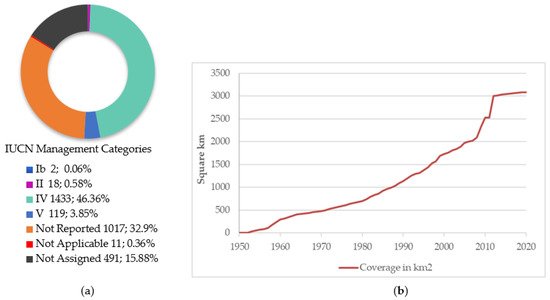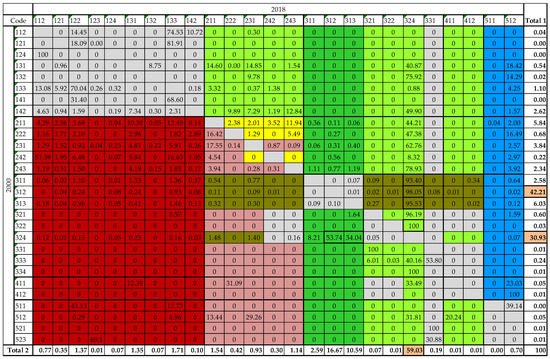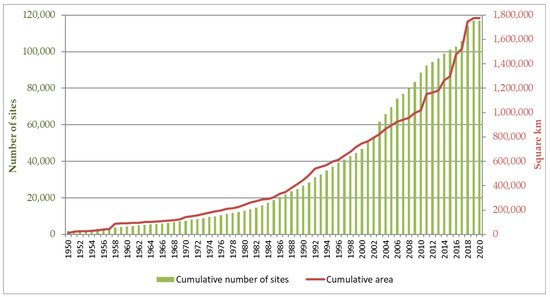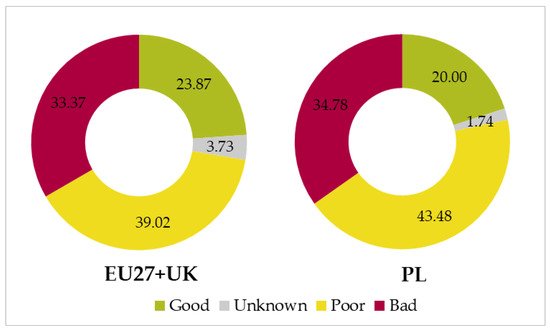2.1. Area
According to the Nature Conservation Act, there are 10 forms of nature conservation in Poland (Table 2): 8 forms of surface protection and 2 forms of individual protection (objects or species) [31]. The Polish definitions of these areas do not always coincide with International Union for Conservation of Nature (IUCN) categories of protected areas (Figure 3). For example, according to the criteria used by the IUCN, none of the 1499 Polish nature reserves has been classified as a Strict Nature Reserve (category I), and only 1 is classified as Ib (Wilderness area). The remaining majority was classified into the “Not Reported” group. Furthermore, only 16 of 23 Polish national parks have the status of an “international” national park (category II), while the rest are classified as category V, a protected landscape area, or not reported [
| PAs |
PABs |
PAs |
PABs |
PAs |
PABs |
PAs |
PABs |
PAs |
PABs |
PAs |
PABs |
|---|
| −4.83 |
+20,840,050 |
17,308,300 |
| 2. |
National parks |
22 |
| Urban greenery |
+8020 (61.5) |
+4804 (25.5) | 23 |
306.5 |
315.1 |
| 0.06 |
0.09 |
0.54 |
−1.62 |
+691,700 |
+607,600 |
3. |
Landscape parks |
120 |
124 |
| Urban areas |
+53,952 |
+99,985 |
0.4 |
1.88 |
0.35 |
−4.15 |
6 078 |
4 252 |
−2,786,047 |
−100,039 |
54.23 |
38.73 |
| Urban greenery |
+3431 |
+2846 |
0.03 |
0.05 |
0.17 |
−1.35 |
271 |
250 |
−29,208,137 |
−1,661,509 |
7.68 |
5.96 |
| 2446.9 |
2531.8 |
| −2.63 |
−12,651,400 |
−6,680,300 |
| Arable land |
4. |
Natura 2000 areas |
x |
| Arable land |
−244,672 (−6.5) |
−132,426 (−5.1) |
−157,168 |
−110,277−1.83 |
−1.18−2.93 |
0.99 |
−2.43 |
0.68 |
−2.29 |
−2 365 |
−644 |
2212 |
2403 |
−10.45 |
145 (SPAs)
849 (SACs) |
x |
4911.4 (SPAs)
3491.3 (SACs) |
| −4.63 |
Pastures 1 |
−250,453 (−9.5) |
−127,760 (−13.9) |
−1.87 |
5. |
Protected landscape areas |
| Pastures 1 |
−148,921 |
−83,988 | −2.58 |
−4.14 |
−2.01 |
−14,049,450 |
−1.11 | −13,180,100 |
| −1.7 |
−2.77 |
−1.32 |
−1 428 |
−2 306 |
10,274 |
43,977 |
−12.93 |
−17.89 |
407 |
407 |
7137.7 |
6925.6 |
| Forests |
+145,255 (2.4) |
| Forests | +83,128 (7.0) |
1.09 |
1.41 |
−1.4 |
1.04 |
+6,282,250 |
+5,323,100 |
| +87,605 |
+64,426 |
450 |
1 312 |
21 |
−3085 |
5.54 |
5.54 |
6. |
Landscape-nature complexes |
170 |
263 |
78.1 |
118.8 |
| Shrubs and scrub |
| Shrubs and scrub | +143,136 (66.1) |
+58,284+50,960 (97.2) |
+33,4931.07 |
0.440.97 |
0.63−8.4 |
−7.62−0.71 |
−0.71+12,803,300 |
2 650+5,295,800 |
| 1 858 |
203,713 |
−2,027,190 |
36.72 |
24.97 |
7. |
Open spaces |
−2529 (−18.4) |
−895 (−22.2) |
−0.02 |
−0.02 |
20.39 |
−0.79 |
−228,700 |
−126,700 |
| 0.66 |
1.09 |
−2.77 |
0.81 |
Ecological areas |
6113 |
7654 |
44.9 |
| Open spaces |
−1000 |
−537 |
−0.01 |
−0.01 |
12.41 |
−0.45 |
−54 |
−68 |
2,151,017 |
−7,603,132 |
−3.13 |
−2.59 |
Wetland |
+2680 (2.8) |
−386 (−6.2) |
0.02 |
−0.01 |
−7.13 |
−2.73 |
+372,400 |
−22,800 |
| Water |
+10,047 (2.2) |
+5872 (7.3) |
0.08 |
0.1 |
2.82 |
1.9 |
+529,750 |
+357,400 |
1 Pastures and mixed crops.
The increase in the urbanized areas observed in the protected areas was even greater than in the surrounding buffer zone (
Table 3). In contrast to the buffer zone (PABs), in the protected areas (PAs) the average area of urbanized patches (AREA_MN) increased, while the Splitting Index (SPLIT) value decreased, which indicates that these areas are more consolidated. At the same time, the increases in Total Core Area (TCA) and Core Area Percentage of Landscape (CPLAND) shown in
Table 4 revealed a 77.4% increase in urban core areas in PAs and 44.9% in PABs. In addition, the mean size of urban core areas (CORE_MN) increased by 0.35 ha in PAs and decreased by 4.15 ha in PABs. The rate of increase of urban core areas in PAs and PABs was lower than the rate of increase for the total urban area (
Table 3), suggesting that the emergence of isolated urban areas contributes to urban expansion more than the sprawl from existing urban areas. The phenomenon is more intense in the buffer zone. This is also confirmed by the increase in the value of the Landscape Shape Index, which indicates a more irregular shape of built-up areas compared to 2000.
Table 4. Changes in selected core area and aggregation metrics between two dates (2000–2018) calculated at the class level for protected areas (PAs) and 1 km buffer zones (PABs).
| Land Cover Type |
TCA [ha] |
CPLAND [%] |
CORE_MN [ha] |
NP |
SPLIT |
| 55.4 |
| 8. |
| Documentation sites |
| 103 |
| 178 |
1.0 |
1.0 |
| Wetland |
180 |
−274 |
0 |
−0.01 |
−6.15 |
−1.77 |
67 |
56 |
−24,042 |
2,601,001 |
2.21 |
0.04 |
| Water |
+4919 |
+4557 |
0.04 |
0.08 |
1.41 |
1.47 |
−7 |
36 |
486 |
−808 |
1.03 |
1.27 |
1 Pastures and mixed crops.
The core area and aggregation metrics reveal that although the total forest area increased between 2000 and 2018, the average area of the patches (AREA_MN) and the average area of the core (CORE_MN) decreased in PAs. Furthermore, the number of patches increased by 450 within the PAs and by 1312 in the PABs. In addition, the 20.7 increase in Splitting Index shows that there is now more forest patches as compared to 2000, a sign of fragmentation. In the buffer zone, the mean patch and core size increased. Coupled with the declining Splitting Index, this indicates a lesser fragmentation problem.
In contrast to forest areas and urban areas, agricultural areas experience decreases in their core and total area. This is the case both within the protected areas and in the buffer zone. Metrics pertaining to aggregation (
Table 4) reveal that arable areas and pastures did not only shrink between 2000 and 2018, but it also became more fragmented. It is true that the number of patches (NP) decreased as a result of a reduction in the total arable land area of 6.5% (in PAs) and 5.10% (in PABs), and of pastures, meadows, and mixed crops by 9.5% and 13.8%. However, the splitting index, which increases with more fragmented patches, rose by more than 2000 for arable land and more than 10,000 for pastures and mixed crops in PAs. In the PABs, the splitting index of pastures and mixed crops increased by over 43,000 from 2000 to 2018. These changes in value suggest an increasing fragmentation of these areas.
Overall, land cover changes within protected areas were less frequent than outside (
Figure 5), although they still amounted to 143,859 hectares (1.24% of all national forms of protected areas) from 2012 to 2018. In some parts of Europe, urbanization and intensification of agriculture still accounted for up to 25% of land cover changes within protected areas
[21]. There is no such problem in Poland. Urbanization and intensification of agriculture accounted only for 5.6%, 7.2%, and 5.3% of land cover changes within protected areas in three analyzed periods.

Figure 5. Land cover flows (LCFs) in protected areas (PAs) (
a) and 1 km protected area buffers (PABs) (
b) as shares of total areas. LCF1 = Urbanization, LCF2 = Intensification of agriculture, LCF3 = Extensification of agriculture, LCF4 = Afforestation, LCF5 = Deforestation, LCF6 = Formation of water bodies, LCF7 = naturalization or land reclamation.
The results of land cover flows (LCFs) in various forms of protected areas and 1 km protected area buffers (PABs) showed that land cover changes were the most frequent in Natura 2000 sites (altogether for bird and habitat sites, it was 3.8% of the area in the period 2012–2018 and 4.5% of the area in the period 2006–2012) (
Figure 6). This is understandable to some extent, as economic and construction activities are permitted in these areas as long as it does not endanger the habitat or species for which they are established. It is worrying that these changes are greater than in unprotected (buffer) sites.
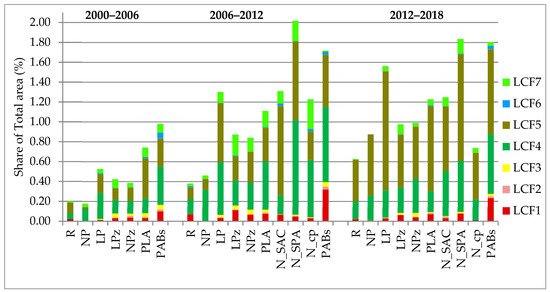
Figure 6. Land cover flows (LCFs) in various forms of protected areas and 1 km protected area buffers (PABs) as shares of total modeled areas. R = Nature reserves, NP = National parks, LP = Landscape parks, LPz/ NPz = parks buffer zones, PLA = Protected landscape areas, N_SAC = Natura 2000 Habitats Special Areas of Conservation, N_SPA = Natura 2000 Birds Special Protection Areas, N_cp = Natura 2000 common part of Bird and Habitat Areas. LCF1 = Urbanization, LCF2 = Intensification of agriculture, LCF3 = Extensification of agriculture, LCF4 = Afforestation, LCF5 = Deforestation, LCF6 = Formation of water bodies, LCF7 = Naturalization/Land reclamation.
Nevertheless, the national forms of nature protection adopted in Polish law can be considered effective. National reserves, national parks, and landscapes are subject to slight urbanization changes (LCF 1). The transformations of agricultural and forest areas into anthropogenic areas are the greatest threat and the image of urbanization pressure. In this context, the greatest pressures were recorded in the buffer areas. However, on the other hand, human settlements increased around almost every protected area, potentially increasing human activity along the edges of protected areas and threatening their ecological integrity. Urban expansion around protected areas varied, but overall, their area increased by almost 49% between 2000 and 2018. In protected areas, this increase was even greater (85%), so that the share of urbanized areas in the structure of land use increased by almost 1.5%.
